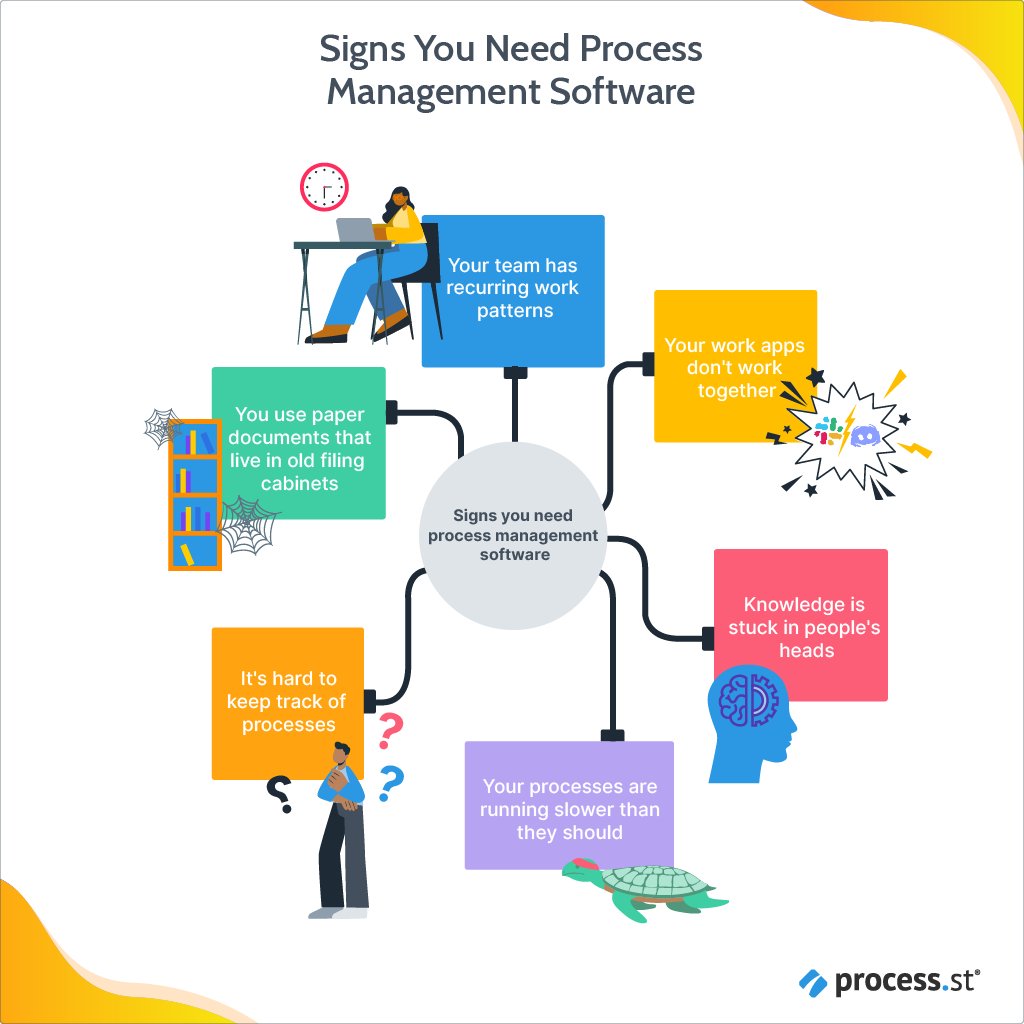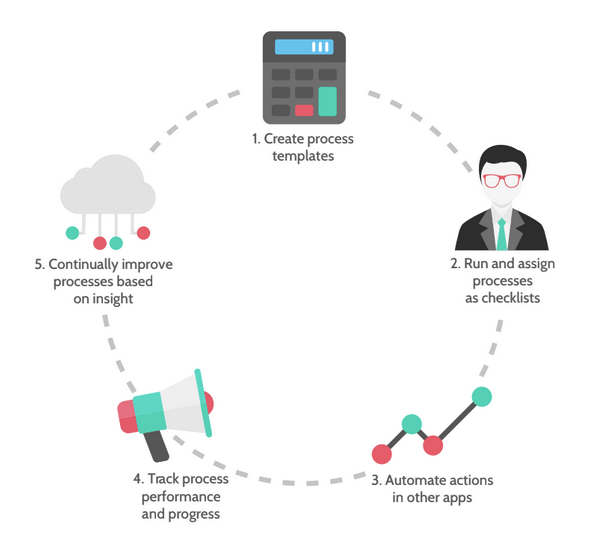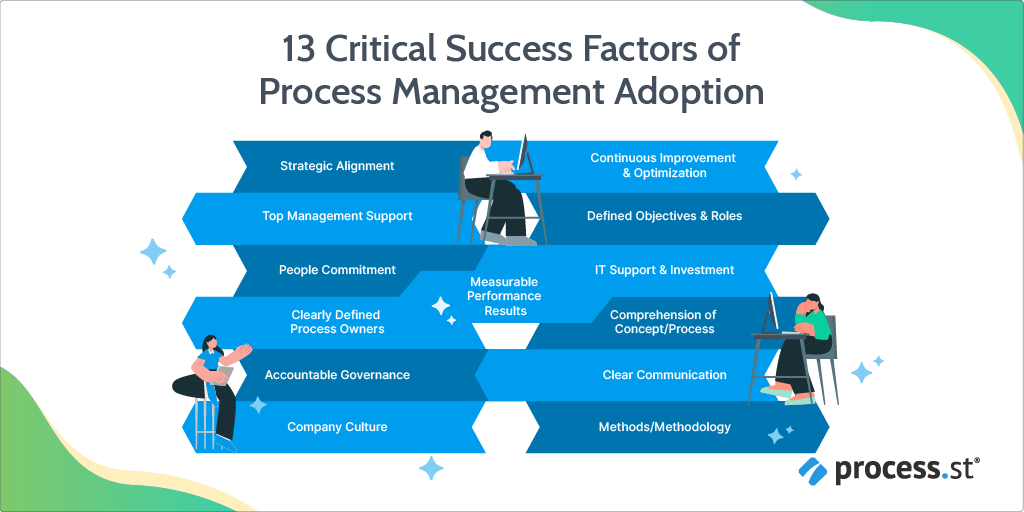Get work done right, and right-on-time with our industry leading BPM platform.
Definition of Process Management: What It Is and Why You Need It Immediately
A business can only function to its fullest potential with proper process management. But what is the actual definition of process management?
As many businesses converted to remote work during the 2020 pandemic, a lot of process management became digital as well. While employees eventually returned to their offices, process management had found a new home in the cloud.
With this sudden change and interest in perfecting process management, it’s worth doing a deep dive into what process management actually is. And as a company that, in all honestly, benefitted from that shift, we have a lot to say on the matter.
In this article we will define process management, talk about its benefits and challenges, and give you advice on how to implement it into your business.
At the end, we’ll even throw in a free template to help you get started.
The definition of process management
Okay, so what is process management exactly?
Process management – or business process management (BPM) – is the technique used by organizations to analyze, optimize, monitor, and control various business processes.
With BPM, companies are able to:
- Automate recurring processes, so they always run smoothly
- Analyze past processes to see what went right and what didn’t
- Track metrics across different processes
- Perform risk analysis to mitigate future risks
- Measure efficiency using previous data
Why bother with process management?
BPM is something every organization needs because it helps you better understand your business.
By using BPM, you can analyze all of your business processes to find inefficiencies and come up with solutions to fix and optimize them. It makes everyday operations run much smoother and improves the management of resources.
But those are just the small benefits.
The other benefits of doing this are immense. Not only does it save your organization time and money, but it also allows your business to respond to customer and market demands much faster.

Benefits of clearly defining process management
Understanding the definition of BPM means you can better differentiate it from program and project management. Knowing the difference between the three types of processes means you will be able to use them all effectively.
With BPM, it’s important to remember that it’s for recurring processes within your organization. These are generally ongoing processes within a business and don’t have a specific end, like employee onboarding. That’s its biggest differentiating factor.
Project management is the delivery of a specific product or service. There is a clear beginning and end to it. Projects are generally one-time things that don’t repeat, and a team may only work on one at one time.
Program management is somewhere in between the other two. It deals with managing the interdependencies between different projects. Like BPM, program management is generally ongoing, but unlike BPM, it doesn’t deal with the processes related to the business as a whole.
Benefits of using process management
Process management is a critical aspect of any business operation, aiming to improve efficiency, reduce costs, and enhance overall performance. Here are some key benefits of utilizing process management:
Increased efficiency
Implementing process management allows organizations to streamline their operations, eliminating redundant tasks, and improving productivity. With clearly defined processes, employees can work more efficiently, leading to time and cost savings.
Continuous improvement
By using process management, businesses can continuously monitor and assess their processes to identify areas of improvement. This enables them to make necessary adjustments, optimize workflows, and enhance performance on an ongoing basis.
Enhanced customer service
With improved efficiency and streamlined processes, organizations can provide better customer service. Processes such as order fulfillment, complaint resolution, and customer onboarding can be standardized and executed consistently, resulting in improved response time and customer satisfaction.
Cost savings
Process management helps identify bottlenecks, redundancies, and inefficiencies, allowing businesses to optimize their resource allocation and reduce costs. By eliminating unnecessary steps and automating manual processes, organizations can achieve significant cost savings.
Improved decision making
Process management provides businesses with real-time data and insights into their operations. This enables them to make informed decisions based on accurate information, leading to better business outcomes and strategic goals achievement.
Types of process management
Process management can do a lot to help you reach your business goals, but you need to be familiar with the different types to know which is best for you.
Business process management
This type of process management focuses on improving business processes and workflows across different departments or functions within an organization. It aims to optimize processes, enhance efficiency, and align them with strategic goals. Business process management software is a great way to help you set up a process management system.
Project management
Project management involves planning, executing, and monitoring a specific project to achieve specific objectives within a defined timeframe. It ensures that projects are delivered on time, within budget, and meet the desired quality standards.
Workflow management
Workflow management focuses on the coordination and optimization of tasks, activities, and approvals within a defined process. It ensures that work is routed efficiently, deadlines are met, and all necessary steps are completed.
Program management
Program management involves managing multiple related projects as a coordinated effort to achieve organizational objectives. It involves overseeing the planning, execution, and monitoring of multiple projects and ensuring their alignment with strategic goals.
Robotic process automation (RPA)
RPA involves the use of software robots or bots to automate repetitive and rule-based tasks. It aims to improve efficiency, accuracy, and speed by reducing manual intervention and minimizing errors.
How to educate your team on the definition of process management
Team members are more susceptible to change than many managers tend to give them credit for. However, far too often, BPM is met with a “set and forget” kind of attitude. There’s very little change.
When it comes to educating your team on the definition of process management, your approach is more important than how you word the definition. Ask yourself this:
- Why do I want my team to know the definition of process management?
- How will the team benefit from knowing the definition?
- What are my expectations of the team after we discuss BPM?
- Do I want my team’s ideas, or do I just want them to know what BPM is in general?
If you just want your team to know what BPM is, then your approach probably isn’t the right one.
Your team members are the ones working with established processes every day, and they probably already know what could be improved. When you introduce process management to your team, it should be a way for you to open up that line of communication with your team.
They should be comfortable coming to you with their ideas for improving processes from this point forward. Their ideas should always be listened to.

Business process management models defined
Modeling business process management is the act of representing an organization’s processes so they can be analyzed, improved, and potentially automated.
The whole idea of BPM models is to have a physical representation of a process laid out in a way that makes sense to anyone who looks at it, whether it be engineers or stakeholders. Think of it as like a mind map.

Examples of process management models
How you go about modeling your business processes is up to you, but there are a few well-established models to help you get started.
Flow charts
Probably the most well-known models, flow charts are simple and easy to make. Just by using a variety of shapes connected by arrows, you can easily demonstrate how certain parts of a process flow into another.
These generally work best for simple processes or simplifying more complicated ones.
Business Process Modeling Notation
The Business Process Modeling Notion (BPMN) maps out business processes using a graphical notation. Created by Object Management Group (OMG), the goal of BPMN is to make even the most complex business processes comprehensible to everyone on a team, from software developers to business analysts.
You can actually learn how to create a BPMN free on OMG’s website if this is the model you want to go with.
Gantt charts
Gantt charts were created by American mechanical engineer Henry Gantt and have been around for more than 100 years. These charts are best used for processes that are time sensitive as they use bars to track deadlines of certain tasks or projects.
Gantt charts are sequential and very easy to understand. There’s a good reason they’re still commonly used today.
Data flow diagrams
Data flow diagrams (DFDs) allow you to visualize data streams. DFDs work like flow charts but generally have a much larger key to help keep the various shapes and colors clear and organized.
These help so you can see how data flows within a process and between processes as well. They are generally better for your team and not stakeholders because they can get a bit convoluted depending on how much data is being represented.

Implementing a process management system
Implementing a process management system, even for individual processes, doesn’t have to be complicated. Just follow these steps:
Clearly define the goals and objectives
This will provide the foundation for identifying the critical processes that need to be managed and improved. By ensuring alignment between the process management system and the overall business strategy, organizations can prioritize their efforts and make better decisions regarding process optimization.
Map out the existing processes
This involves documenting the steps, inputs, outputs, and stakeholders involved in each process. The process mapping exercise provides a visual representation of the sequence of activities and helps identify potential bottlenecks, inefficiencies, and redundancies in the processes.
Identify improvement opportunities
This is done by evaluating the efficiency, effectiveness, and performance of each process. Key performance indicators (KPIs) can be defined to measure the success of the processes and track progress towards improvement goals.
Optimize the processes
Process improvement can be achieved through a variety of approaches, such as:
- Eliminating unnecessary steps
- Automating manual tasks
- Redefining roles and responsibilities
- Implementing best practices from industry standards
By continuously monitoring and analyzing the processes, organizations can identify areas of optimization and implement changes to drive efficiency.
Challenges with implementing a new process management system
Implementing a new process management system can come with its fair share of challenges. Here are some of the common obstacles organizations may encounter during this process:
Resistance to change
Implementing a new process management system often requires a shift in mindset and changes to established workflows. Resistance to change can come from employees who are accustomed to existing processes and may be hesitant to adopt new ways of working.
Lack of buy-in
Successful implementation of a process management system relies on the support and buy-in from key stakeholders. If decision-makers and leaders do not fully understand the benefits or see the value in the system, it can be challenging to gain the necessary support and resources.
Limited resources
Implementing a new system requires investment in technology, training, and resources. Limited budgets or resource constraints can pose challenges in terms of procuring the necessary tools and allocating the right people to drive the implementation process.
Data management
Implementing a process management system often involves collecting and analyzing large amounts of data. Managing and organizing this data effectively can be a challenge, especially if organizations do not have efficient data management processes in place.
Integration with existing systems
Organizations may already have established systems and tools in place, and integrating the new process management system with these existing systems can be a complex task. Ensuring seamless integration and smooth data flow between different systems can present challenges.
Process management templates
Check out our blog post on essential processes for HR teams. It’s sometimes better to implement BPM in HR teams first, and this post contains 60 free templates for your team to try out.
If you’re having a difficult time deciding which one to try first, I recommend this one:
How to optimize your process management system
Optimizing your process management system is all about establishing a system of continuous improvement.
Continuous improvement means never settling. There is no “This works great, let’s leave it as is,” but rather an attitude of, “This works great, but is there a way to make it even better?”
We have a whole blog post full of advice on how to use continuous improvement to optimize processes if you want to learn more.







